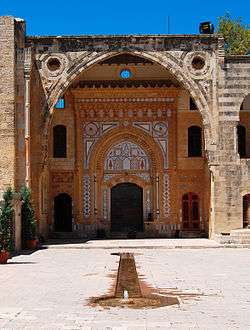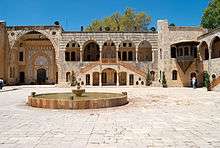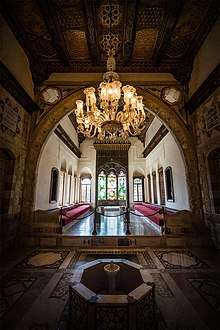Beiteddine Palace
Beiteddine Palace (Arabic: قصر بيت الدين) is a 19th-century palace in Beiteddine, Lebanon. It hosts the annual Beiteddine Festival and the Beiteddine Palace Museum.

| Beiteddine Palace | |
|---|---|
| Native name قصر بيت الدين | |
 Beiteddine Palace - Inner Courtyard | |
| Location | Beiteddine, Lebanon |
| Built | 1788 - 1818 |
| Architectural style(s) | 19th century Lebanese architecture |
History
Emir Bashir II of the Shihab dynasty, who later became the ruler of the Mount Lebanon Emirate, built the palace between 1788 and 1818 at the site of the Druze hermitage. After 1840, the palace was used by the Ottomans as a government building. During the French Mandate it served as a local administrative office.
In 1943, the palace was declared the president's official summer residence. During the Lebanese Civil War it was heavily damaged. Parts of the palace are today open to the public while the rest is still the president's summer residence. [1]

A gathering of troops here for an incursion into Syria under Ibrahim Pasha is recorded in the notes to Letitia Elizabeth Landon's poem The Gathering of the Chieftains at Beteddein in Fisher's Drawing Room Scrap Book, 1839.
| Wikisource has original text related to this article: |
Visiting the palace

The main entrance leads to a 107x45 meter courtyard. Along the right side of this court is a two-story wing, Al-Madafa, which was once used for receiving guests.
The entrance to the central section of the palace, Dar El Wousta, is from a double stairway at the far western end of the courtyard. From this point on, the impressive but austere appearance of the outside court and buildings gives way to the delightful architecture featuring beautiful arcades, mandaloun balconies, fountains, facades, rooms with carved and painted cedar wood embellished with Arab calligraphy, antique furniture, inlaid marble and fine mosaics.[2] These rooms served as offices and receptions salons.
At the far end of this courtyard rise the private apartments, Dar el Harim, composed of a large and richly decorated façade, the Upper Harem, the selamlik, the Lower Harem and the kitchens.
At the northern edge of the Dar El Harim section is the hammam.
Beyond the hammam is the tree-shaded tomb of Emir Bashir Shehab II and his first wife.